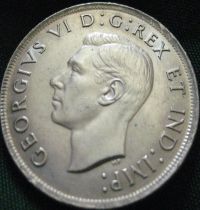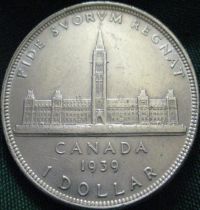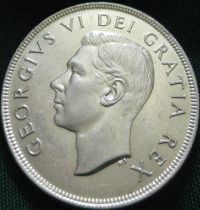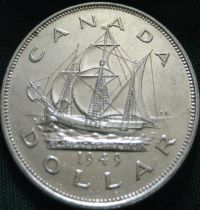
King George VI
Canadian Commemorative
Silver Dollars
With the death of King George V in January of 1936 and the abdication by Edward VIII in December of 1936, George VI ascended to the throne. His image appeared on Canada's dollar and other silver coins beginning in 1937 and continued through 1952, the year of his death.
During his reign, two commemorative silver dollars were struck:
the 1939 Royal Visit Silver Dollar and the 1949 Newfoundland
Silver Dollar. Here are the details on these two Canadian coins.
1939 Royal Visit Commemorative Canadian Dollar
 This 1939 commemorative silver dollar features the image of George
VI (without crown) on the obverse. Around the coin's rim appears
GEORGIVS VI, D:G: which is an abbreviation of Dei Gratia ("God's
Grace" also stated as "by the grace of God"), REX (Latin for King)
and ET IND: IMP: ("and emperor of India"). Click on either image
for a larger view.
This 1939 commemorative silver dollar features the image of George
VI (without crown) on the obverse. Around the coin's rim appears
GEORGIVS VI, D:G: which is an abbreviation of Dei Gratia ("God's
Grace" also stated as "by the grace of God"), REX (Latin for King)
and ET IND: IMP: ("and emperor of India"). Click on either image
for a larger view.
 The reverse of this coin highlights King George VI's Canadian
visit in that year, the first by a reigning British monarch. The
image is of the Parliament Building in Ottawa with Latin
inscription above that translates to "He reigns by the faith of
his people". Below is imprinted CANADA as the issuing country, the
1939 date and the denomination of 1 DOLLAR.
The reverse of this coin highlights King George VI's Canadian
visit in that year, the first by a reigning British monarch. The
image is of the Parliament Building in Ottawa with Latin
inscription above that translates to "He reigns by the faith of
his people". Below is imprinted CANADA as the issuing country, the
1939 date and the denomination of 1 DOLLAR.
A total of 1,363,816 Royal Visit Silver Dollars were minted which includes the higher-grade Specimen Strike Dollars. Most are worth their silver melt value plus the current premium. Most valuable are the Mint State Strikes MS-64 and higher and the Specimen Strikes in the higher grades of SP-63 and up which are worth several hundred dollars.
Canadian silver dollars minted from 1935 through 1967 are 80%
silver and 20% copper. Silver content is .600 troy ounces although
a well worn coin will contain less. To
determine the intrinsic (silver melt) value of a 1939 Canadian
dollar multiply .6 times the current spot price of
silver.
Example: CAD $40.00 x .6 = $24.00
1949 Newfoundland Commemorative Canadian Dollar
 This 1949 commemorative silver dollar features the image of George
VI (without crown) on the obverse. Around the coin's rim appears
GEORGIVS VI, D:G: which is an abbreviation of Dei Gratia ("God's
Grace" also stated as "by the grace of God") and REX (Latin for
King). With India's declared independence in 1947, the ET IND:
IMP: ("and emperor of India") was removed. Click on either image
for a larger view. Click on either image for a larger view.
This 1949 commemorative silver dollar features the image of George
VI (without crown) on the obverse. Around the coin's rim appears
GEORGIVS VI, D:G: which is an abbreviation of Dei Gratia ("God's
Grace" also stated as "by the grace of God") and REX (Latin for
King). With India's declared independence in 1947, the ET IND:
IMP: ("and emperor of India") was removed. Click on either image
for a larger view. Click on either image for a larger view.
 The reverse of this coin features a ship (the Mathew) on which
John Cabot reportedly landed on Newfoundland in 1497. Beneath the
waves of the ship is inscribed FLOREAT TERRA NOVA - Latin for "May
the new land flourish". Above the ship is CANADA as the issuing
country with the 1949 date and the denomination of (one) DOLLAR
below.
The reverse of this coin features a ship (the Mathew) on which
John Cabot reportedly landed on Newfoundland in 1497. Beneath the
waves of the ship is inscribed FLOREAT TERRA NOVA - Latin for "May
the new land flourish". Above the ship is CANADA as the issuing
country with the 1949 date and the denomination of (one) DOLLAR
below.
A total of 672,218 Newfoundland Silver Dollars were minted which includes the higher-grade Specimen Strike Dollars. Most are worth their silver melt value plus the current premium. Most valuable are the Specimen Strikes in the higher grades of SP-63 and up.
To determine the intrinsic (silver
melt) value of this 60 percent silver coin multiply .6 times the
current spot price of silver.
Example: USD $30.00 x .6 = $18.00
If you are shopping for these commemorative coins and live in
Canada, a likely starting point for your purchases would be at
your local coin shop or even area coin shows. If you are a U.S.
citizen or a Canadian visiting the U.S., you may have better luck
at coin shops or shows in one of the states bordering Canada. I
have found coin shops further south of the Canadian border are a
"little light" on their knowledge and inventory of Canadian coins.
Good luck.
Disclaimer: I have made every reasonable effort to produce an informative and helpful article on King George VI Commemorative Silver Canadian Dollars based on my research and experiences. However, I make no representation or warranties of any kind with regard to its completeness, accuracy or suitability for any specific situation or purpose. See Terms and Conditions for more info.